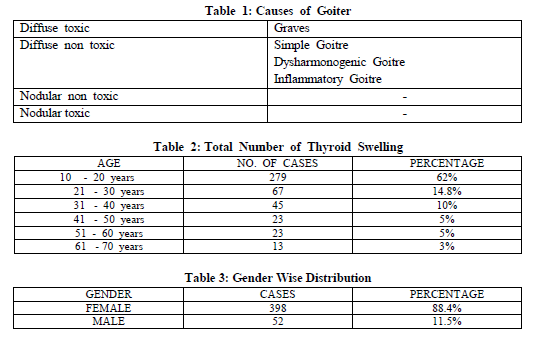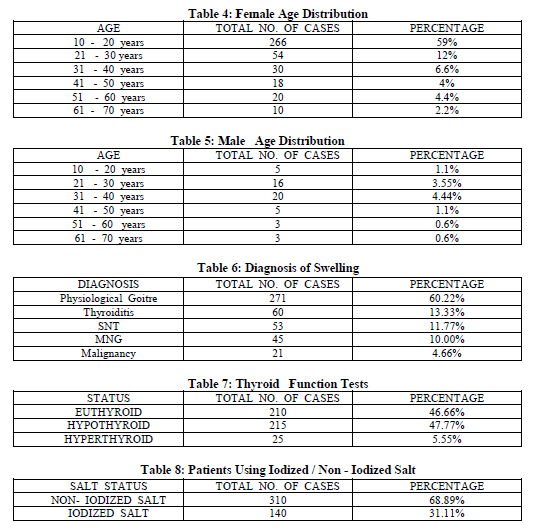IJCRR - 5(17), September, 2013
Pages: 24-27
Date of Publication: 12-Sep-2013
Print Article
Download XML Download PDF
A STUDY ON GOITRE - IN A TERITIARY CARE HOSPITAL
Author: C. P. Ganesh Babu, K. Karunakaran
Category: Healthcare
Abstract:A total of 450 cases of Goitre is studied from January 2006 - October 2009 in a tertiary care hospital. Aim: To evaluate the cause and diagnosis of thyroid swelling in MAPIMS. Materials and Methods: All cases were evaluated by performing thyroid function tests, ultrasound neck, FNAC. Patients were classified according to age distribution, gender, according to symptoms of Hypothyroid, Euthyroid, Hyperthyroid Conclusion: More than 60% of the patients were suffering from Physiological Goitre. 15% were solitary nodule, 15% were Multinodular, 5% were Hashimotos, 5% malignancy. In our area most of the patients were suffering from Physiological Goitre due to low usage of iodized salt which is epidemiologically important.
Keywords: Goitre, iodized salt.
Full Text:
INTRODUCTION
Goitre is defined as enlargement of thyroid gland. Causes for goitre is wide open from benign to malignant conditions (table 1).(1). Even though national health programme has been initiated in India, still in many regions of India people use non -iodized salt only.
MATERIALS AND METHODS
A total of 450 cases of thyroid swelling were studied in MAPIMS from January 2006 to October 2009. Investigations performed were thyroid function tests, ultrasound thyroid, fine needle aspiration. Patients were classified according to age distribution, gender, and according to symptoms of Hypothyroid, Euthyroid and Hyperthyroid. And patients usage of iodized salt or not has also been used in the inclusion criteria.
RESULTS
Age distribution was from 10years to 70 years in our study. Most patients presented to our out - patient were in between 10 - 20 years of age (62%), next 21- 30 years (14.8%). (Table 2), (table 3). (R 2, R 3)
In female population alone 266 cases were reported in between age 10 -20 years , 54 patients were in the age 21 – 30 years. (table 4). In male population , more number of cases were reported in the age group of 31 - 40 years around 20 cases.(table 5).
According to the diagnosis, physiological Goitre cases were the commonest 271 cases(60.2%). next most common diagnosis is Thyroiditis.(table 6). Most of the patients were either Hypothyroid or Euthyroid. (table 7). (R 4). Comparing the usage of iodized salt , around 68.89% (310 cases) were not using iodized salt.( table 8).
DISCUSSION
Our study demonstrates the presence of significant amount of Physiological goiter in a particular geographical area inspite of the government agencies efforts in popularizing the use of iodized salt. 271 cases (60.22%) of Goitre in our area is Physiological Goitre due to lack of health education about iodized salt. 310 cases (69.89%) were not using iodized salt. In the 271 cases of physiological Goitre 250 cases were not using iodized salt and the remaining 21 cases inspite of usage of iodized salt usage they had Goitre due to low intake of salt. Even though majority of the population is not using iodized salt i.e, iodine deficiency prevalent in the community, why female patients are predominantly suffering from Physiological goiter.
Another paradox in our study, in the male population physiological goiter is more common in the age group of 31-40 years which is not a physiologically active age group when compared to the age group of 10-20 or even 20-30. These are few questions which have to be addressed or atleast debatable in suitable forums.
CONCLUSION
In our study we have concluded that area in and around hospital most of the people 60.22% were suffering from physiological Goitre due to lack of usage of iodized salt which is epidemiologically significant. Hypothyroidism can be prevented from usage of iodized salt.


References:
- Kabadi, Udaya. M, Abdaliah, Mouin, Goitre: a review of pathophysiology and management, march 2007.
- C.S.Pandav, N.Kochupillai, M.G.Karmarker, L.M. Nath Endemic goitre: why the apathy?, (jun 21 -28, 1986).1121 -1128.
- Reeve.T.S, Ihre -Lundgren. C., poole.A.G, Bambach C, Barraclough . B, The university of Sydney endocrine surgery database: 50 years of data accual, AWZ. JSurg; jan -feb78 (1-2), 7 -52.
- Wait. T, Groenvold. M, Rasmussen AK, Bonnemsa, Hepedug.L, Quality of life in patients with benign thyroid disorders: a review, Eur. J. Endocrinology ; 2006, April (154 (4)), 501- 510.
- Brox – Amel Lamberg , Endemic goitre - iodine deficiency disorders, Annuals of medicine ,1991 volume 23, : 367 -372.
- Broke. E, Brusch M.O, J.K.Atland, Goitre prevention with iodized salt with result of a 30 years study. journal of clinical endocrinology and metabolism ; , volume 12, 1952: 1380 -1388.
- Chandrakant .S.Pander, K. Anand, A. Malik, MG . Kamarker, Prevalance of iodine deficiency disorders among school children of national capital territory Delhi, journal of clinical epidemiology volume 49, jan 1996; 523
- Anderson. M, Takkouche B, Egli, Alien HE, Current global iodine status and progress over the last decade towards elimination of iodine deficiency, Built world health organization, 2005; fs (7), 518 -525.
- Atul Kotwal, Ritu priya, Imrana Qader, Goitre and other iodine deficiency disorder- a systemic review of epidemiological status, Archives of medical research, volume 38, issue 3, april 2007- 2367.
|






 This work is licensed under a Creative Commons Attribution-NonCommercial 4.0 International License
This work is licensed under a Creative Commons Attribution-NonCommercial 4.0 International License